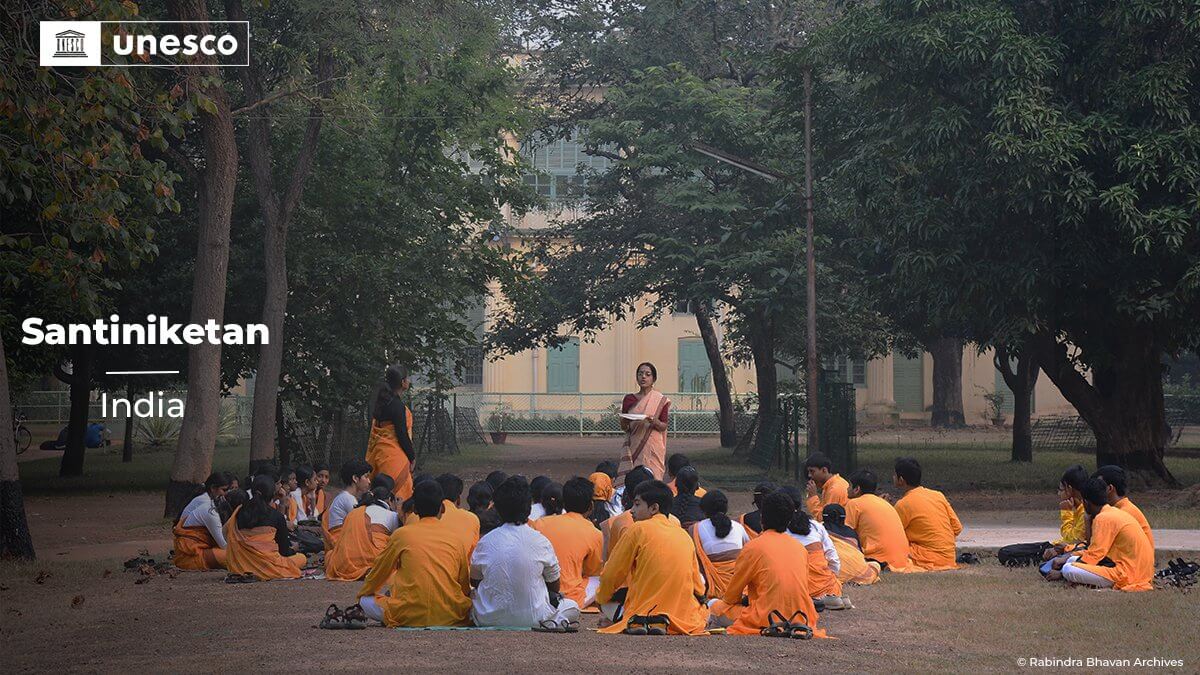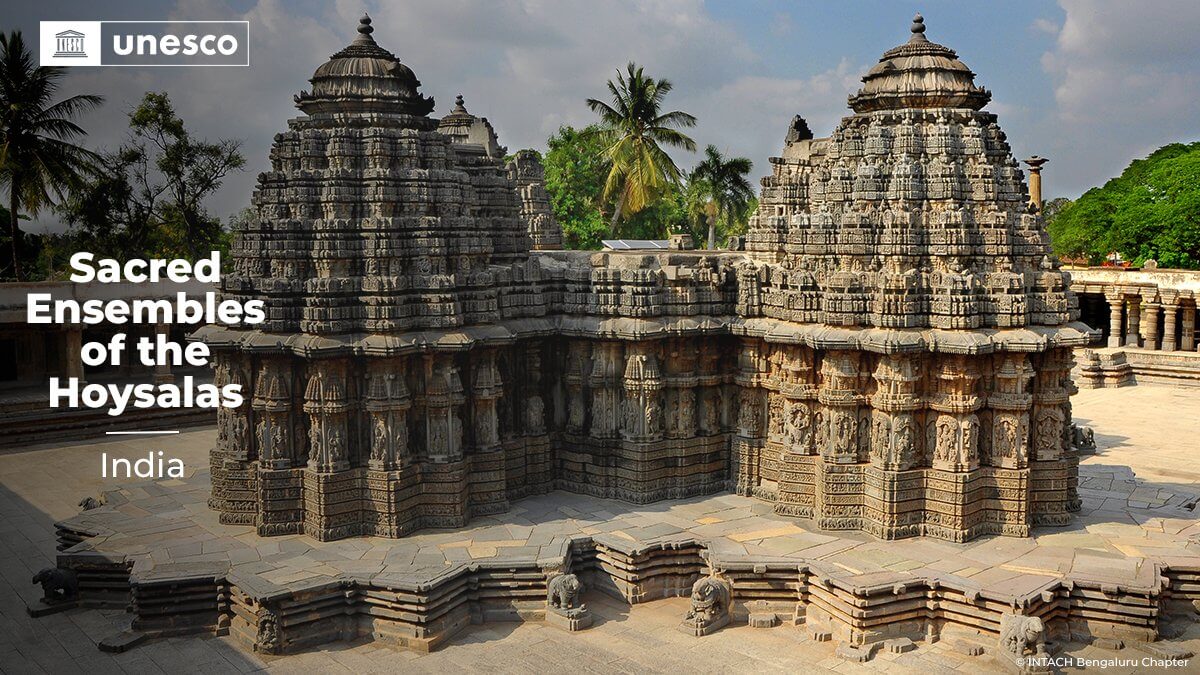India now has 42 UNESCO World Heritage Sites
India’s UNESCO World Heritage Sites have expanded to a total of 42 with the recent additions of the ‘Sacred Ensembles of the Hoysala’ and Santiniketan. These recognitions include 34 sites in the cultural category, seven in the natural category, and one mixed property, showcasing India’s rich and diverse heritage. This achievement is a cause for great joy and celebration for the entire nation.
India’s 41st UNESCO World Heritage Site – Santiniketan
Santiniketan, a town in the Birbhum district of West Bengal, was inscribed on the UNESCO World Heritage List in 2023. Santiniketan is known as the abode of peace and was founded by Nobel laureate Rabindranath Tagore in 1901. It is home to Visva-Bharati University, which was founded by Tagore in 1921.
Santiniketan is a unique place that blends educational institutions, artistic hubs, and natural haven. The campus of Visva-Bharati University is located in the heart of Santiniketan and is surrounded by lush greenery. The campus is home to a number of important buildings and landmarks, including:
- Uttarayan: Tagore’s residence and now a museum
- Santiniketan Ashram: A community center founded by Tagore
- Kala Bhavan: A college of art and music founded by Tagore
- Upasana Griha: A meditation hall
- Cheena Bhavan: A museum of Chinese art and culture

Santiniketan is also known for its vibrant cultural scene. The town is home to a number of theaters, galleries, and museums. Santiniketan is also home to a number of festivals throughout the year, including the Poush Mela, the Basanta Utsav, and the Rabindra Jayanti.
Santiniketan is a significant place in Indian history and culture. It is a place where education, art, and nature come together. Santiniketan is also a place where people from different cultures and backgrounds come to learn and grow.
Santiniketan’s inscription on the UNESCO World Heritage List is a recognition of its importance to humanity. It is a place that is worth preserving and protecting for future generations.
India’s 42nd UNESCO World Heritage Site – Sacred Ensembles of the Hoysala
The Sacred Ensembles of the Hoysala, a group of three Hoysala temples in Belur, Halebidu, and Somanathapura in Karnataka, were inscribed on the UNESCO World Heritage List. These temples are known for their intricate carvings and exquisite architecture.
The Hoysala temples were built by the Hoysala dynasty, which ruled Karnataka from the 11th to the 14th centuries. The Hoysalas were great patrons of art and architecture, and their temples are some of the finest examples of Hindu temple architecture in the world.

The Chennakeshava Temple in Belur, the Hoysaleswara Temple in Halebidu, and the Keshava Temple in Somanathapura are the three main temples in the Sacred Ensembles of the Hoysala. These temples are all dedicated to the Hindu god Vishnu.
The Chennakeshava Temple in Belur is the largest and most elaborate of the three temples. The temple is covered in intricate carvings depicting scenes from Hindu mythology. The Hoysaleswara Temple in Halebidu is known for its intricate stone sculptures and its unique star-shaped plan. The Keshava Temple in Somanathapura is known for its well-preserved carvings and its serene atmosphere.
The Sacred Ensembles of the Hoysala are a testament to the skill and craftsmanship of the Hoysala artisans. These temples are also a testament to the rich cultural heritage of India.
The inscription of the Sacred Ensembles of the Hoysala on the UNESCO World Heritage List is a recognition of their importance to humanity. These temples are a unique and valuable part of the world’s heritage.
All 42 World Heritage Sites in India
India’s impressive collection of 42 UNESCO World Heritage Sites places it among the countries with the highest number of such sites globally. The nations that currently boast 42 or more world heritage sites include Italy, Spain, Germany, China, and France. This remarkable achievement reflects India’s cultural and natural diversity, making it a significant contributor to the world’s heritage preservation.
Cultural (34)
- Agra Fort (1983)
- Ajanta Caves (1983)
- Ellora Caves (1983)
- Taj Mahal (1983)
- Sun Temple, Konarak (1984)
- Group of Monuments at Mahabalipuram (1984)
- Group of Monuments at Hampi (1986)
- Khajuraho Group of Monuments (1986)
- Fatehpur Sikri (1986)
- Churches and Convents of Goa (1986)
- Group of Monuments at Pattadakal (1987)
- Elephanta Caves (1987)
- Great Living Chola Temples (1987, 2004)
- Buddhist Monuments at Sanchi (1989)
- Humayun’s Tomb, Delhi (1993)
- Qutub Minar and its Monuments, Delhi (1993)
- Mountain Railways of India (1999, 2005, 2008)
- Mahabodhi Temple Complex at Bodh Gaya (2002)
- Rock Shelters of Bhimbetka (2003)
- Chhatrapati Shivaji Maharaj Terminus (formerly Victoria Terminus), Mumbai (2004)
- Champaner-Pavagadh Archaeological Park (2004)
- Red Fort Complex (2007)
- The Jantar Mantar, Jaipur (2010)
- Hill Forts of Rajasthan (2013)
- Rani ki Vav (The Queen’s Stepwell), Patan, Gujarat (2014)
- Le Corbusier’s Architectural Work in Chandigarh (2016)
- Nalanda Mahavihara (Nalanda University), Bihar (2016)
- Historic City of Ahmedabad (2017)
- Victorian Gothic and Art Deco Ensembles of Mumbai (2018)
- Jaipur City, Rajasthan (2019)
- Dholavira: A Harappan City, Gujarat (2021)
- Kakatiya Rudreshwara (Ramappa) Temple, Telangana (2021)
- Santiniketan, West Bengal (2023)
- Sacred Ensembles of the Hoysala, Karnataka (2023)
Natural (7)
- Kaziranga National Park, Assam (1985)
- Keoladeo National Park, Rajasthan (1985)
- Manas Wildlife Sanctuary, Assam (1985)
- Sunderbans National Park, West Bengal (1987)
- Nanda Devi and Valley of Flowers National Parks, Uttarakhand (1988 & 2005)
- Western Ghats (2012)
- Great Himalayan National Park Conservation Area (2014)
Mixed (1)
- Khangchendzonga National Park, Sikkim (2016)
These World Heritage Sites represent the rich and diverse cultural and natural heritage of India. They are a testament to the country’s long and rich history, its unique culture, and its natural beauty.
About UNESCO World Heritage Sites
The United Nations Educational, Scientific and Cultural Organization (UNESCO) designates World Heritage Sites for their outstanding value to humanity. They can be natural, cultural, or mixed sites.
- Natural World Heritage Sites include some of the most iconic natural landscapes in the world, such as the Grand Canyon in the United States, the Great Barrier Reef in Australia, and the Serengeti National Park in Tanzania.
- Cultural World Heritage Sites include some of the most important cultural sites in the world, such as the Taj Mahal in India, the Great Wall of China, and the Acropolis in Greece.
- Mixed World Heritage Sites are sites that have both natural and cultural significance, such as the Machu Picchu Archaeological Park in Peru and the Galapagos Islands in Ecuador.
There are currently over 1,150 World Heritage Sites in 166 countries around the world. The selection of World Heritage Sites is a rigorous process, and only sites that are considered to be of outstanding value to humanity are selected.
Benefits of World Heritage Sites
- Preservation and protection: World Heritage Sites are protected by international law and receive financial assistance from UNESCO. This helps to ensure that these sites are preserved for future generations.
- Education and awareness: World Heritage Sites help to educate people about the natural and cultural heritage of the world. They also promote respect for different cultures and ways of life.
- Tourism and economic development: World Heritage Sites can attract tourists from all over the world. This can boost local economies and create jobs.
World Heritage Sites are a valuable part of our global heritage. They represent the best of what humanity has to offer, both in terms of our natural and cultural heritage.
- Weekly Current Affairs 2025 PDF For Bank, SSC, UPSC Exams
- Unsung Heroes of India: 10 Unknown Freedom Fighters You Should Know
- 26 December Current Affairs 2023 in English
- Daily Current Affairs 2025, Check Today’s Current Affairs
- April Month Current Affairs 2024, Download PDF
- June Month Current Affairs 2024, Download PDF

Hello, I’m Aditi, the creative mind behind the words at Oliveboard. As a content writer specializing in state-level exams, my mission is to unravel the complexities of exam information, ensuring aspiring candidates find clarity and confidence. Having walked the path of an aspirant myself, I bring a unique perspective to my work, crafting accessible content on Exam Notifications, Admit Cards, and Results.
At Oliveboard, I play a crucial role in empowering candidates throughout their exam journey. My dedication lies in making the seemingly daunting process not only understandable but also rewarding. Join me as I break down barriers in exam preparation, providing timely insights and valuable resources. Let’s navigate the path to success together, one well-informed step at a time.






